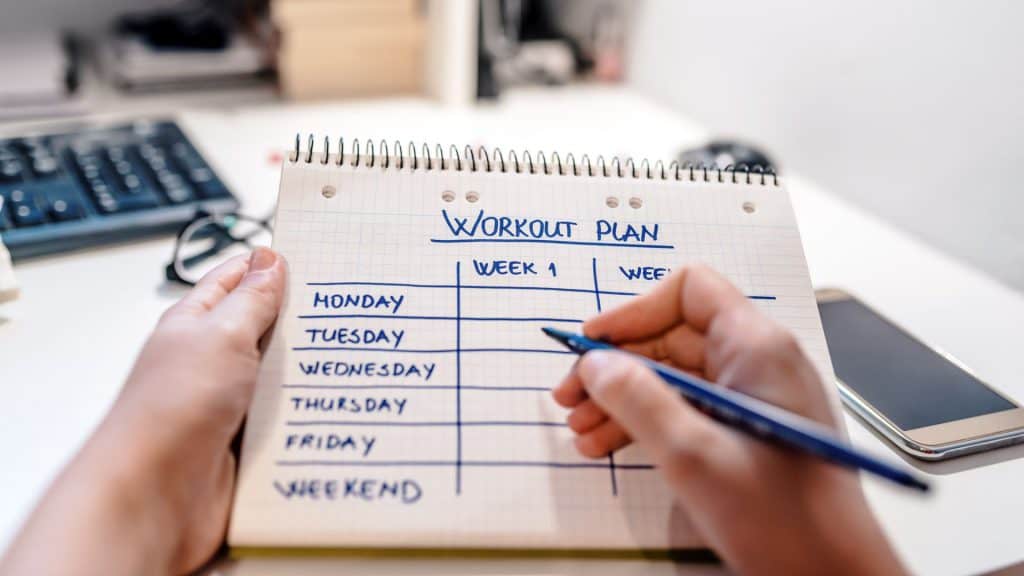Table of Contents
Just Starting on Your Fitness Journey? Try This Daily Training Guide
This program incorporates high-intensity cardio training to burn fat effectively, plus the addition of strength-training to increase your metabolic rate, so you can change the actual shape of your body.
Here’s the recommended output schedule:
Daily Training Guide
Monday/Day 1 Upper Body Training Chest/Shoulders/Triceps/Back/Biceps
Tuesday/Day 2 Cardiovascular Workout
Wednesday/Day 3 Lower Body and Abs Training Quads/Hamstrings/Calves/Abdominals
Thursday/Day 4 Cardiovascular Workout
Friday/Day 5 Upper Body Training Chest/Shoulders/Triceps/Back/Biceps
Saturday/Day 6 Cardiovascular Workout
Sunday/Day 7 Rest
Weight training guidelines:
- Weight train intensely, three times per week on alternating days with aerobic exercise three times per week.
- Alternate training the major muscles of the upper and lower body.
- Perform two exercises for each major muscle group of the upper body.
- Select one exercise and conduct five sets with it, starting with a set of 12 reps, then increasing the weight and doing 10 reps, adding more weight and doing 8 reps, adding more weight for 6 reps. Then reduce the weight and do 12 reps. Immediately perform another set of 12 reps for that muscle group using the second selected exercise.
- For each muscle group, rest for one minute between the first four sets. Then complete the final two sets with no rest in between, wait two minutes before moving on to your next muscle group, complete this pattern five times for the upper body training experience and four times for the lower body training experience.
- Always plan your training before hand.
- Record all your weightlifting exercised in a journal indicating the exercise selected and weight lifted.
Cardio guidelines:
- Choose cardio activity that works for you. This can be any exercise—jogging, running, biking, swimming, elliptical machine, stairs, even jumping rope—that raises and maintains your heart rate over a predetermined amount of time.
- Alternate weight-training and cardio workouts for six consecutive days and rest on the seventh day.
- 20 mins of cardio breaks down to: 2 mins of warm-up at a slower pace, then 16 mins of gradual speed increase to a high-intensity level, then a slow- down period for 2 mins.
- Cardio workouts burn fat, enhance endurance, increase growth hormone secretion, reduce stress levels, improve cholesterol levels, improve digestion, and boost the immune system.
Get that healthy body you’ve always wanted. Make it a personal goal, and you will learn to live a healthy lifestyle and effectively manage your weight loss. Adding a pre workout supplement helps boost your cardio workout.
How to Relax After a Workout
Working out and getting your heart rate up is great for your health. It pushes the blood and oxygen around your body, revitalizing you physically, emotionally and mentally. First thing in the morning is usually the best time to get a good workout in, since it awakens you for the rest of your day, and while using the energy from a workout is great, it very important that you relax afterward.
Relaxation doesn’t mean going home to sit on the couch and gap out at a television for and hour, or rolling out your beach towel with a margarita in hand and soaking up some sun (although the latter is a nice idea). Relaxation is a process that can follow any workout, and can be done step by step.
Why We Need to Relax
The reason relaxation is so important is because when working out you are triggering the sympathetic part of your nervous system. It helps to process the amount of extra stress involved with higher heart rates or straining muscles. It is important that you bring your body back into a parasympathetic state, where it is no longer over stimulated and can begin to recuperate.
Relaxation doesn’t take long, and is a great way to get focused, find clarity and absorb all the benefits of a workout.
Here are some techniques:
- Wait until your heart rate is back to normal and you have done some ‘after workout stretches’ and then lie down on your back in a quite room.
- Breathe slowly and deeply, but don’t do it unnaturally. Let the air fill your lungs and fall away with ease.
- Focus on breathing, in and out, and begin to count, slowly from seven downward. When you get to zero start over.
- If you have something like a towel or shirt, roll it up and place it across your eyes.
- Keep breathing slowly, and try not to let thoughts of work, or plans for the day enter your mind.
- Visualize your body and the workout you’ve just had. See if you can follow from one spot on your body to the next and feel the area without touching it. Go slowly, and if you can’t feel it, just move on.
- Keep breathing and relaxing for at least ten minutes.
- When you are finished, get up slowly. Do things calmly, and get on with your day.
